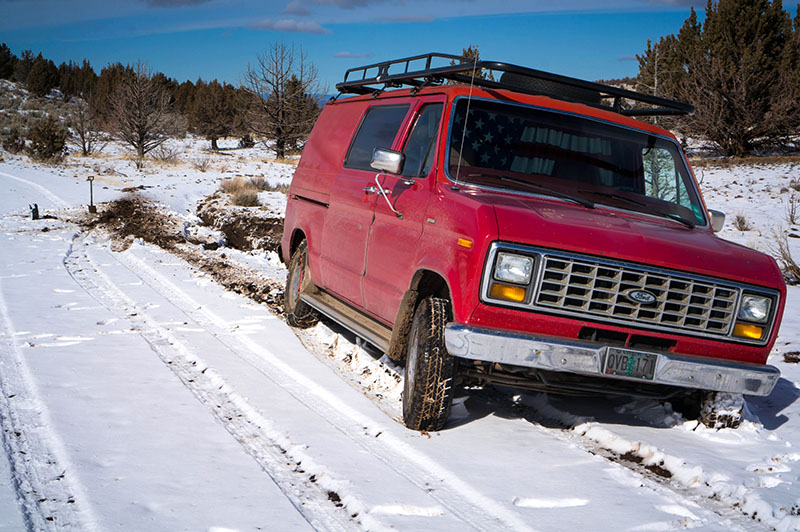
Flinging mud with an old shovel wasn’t how I had planned to spend my morning. I was swamped up to my driver’s side running-board in a ditch, my tires spinning in the slop. Every shovel-load slurped loudly before popping loose.

Earlier that morning, I had been standing in the Peter French Round Barn, fumbling with frozen fingers for photos of historic juniper poles that had labored under the load of a massive wooden roof for the last 150 years. If its walls could talk, they’d tell stories of a shrewd cattle king, herds of Spanish horses, battles with local Indians, and the murder of its namesake. The barn now stands as one of the only reminders of a much wilder time in Oregon history. A special herd of horses stands as another.

In 1977, the Bureau of Land Management (BLM) discovered a small group of wild horses with unique and uniform conformation in the nearby Kiger gorge. DNA testing would show that they were direct descendants of the first horses brought to the Americas by the Spanish in the 16th century — horses previously thought to have gone extinct through interbreeding with feral French and English stock over the centuries.
Roughly a hundred of these descendants now roam an area of 65,000 acres in remote southeastern Oregon. Despite warnings from the BLM about the difficulties of actually finding the horses, I had set out through the snow toward the Kiger Gorge.
I wanted to see these rare mustangs with my own eyes.
That brings us back to the ditch…. I had been digging for two hours and only moved as many feet, and I started to think about my other options for getting out. It would be a day’s hike to the nearest paved road to flag down some help. I could hit the “car trouble” button on my SPOT device, but I hadn’t reprogrammed my contacts after a break-up and wasn’t sure what kind of help I could expect from a scorned lover.

I decided my best option was to climb a nearby butte to see if I could get a call out. I jotted down the GPS coordinates of the van on a scrap piece of paper and began the ascent with a cell phone in hand. I starred at the screen and waited for a bar to show up like I was in one of those old “can you hear me now?” commercials.
I saw bobcat and coyote tracks, rabbit and squirrel tracks, and then, as I neared the summit, horse tracks. Barefoot, riderless horse tracks. Mustang Tracks.
Forgetting the van for a while, I began to follow the hoof prints through the trees. Here and there I found coarse horse hair in the snow and bits of mane or tail sloughed off on the junipers.
I followed the tracks for an hour until I came to a break in the trees where I could see that they continued a long way, over the horizon of a distant plain. I wasn’t packed or dressed to go further, the van was still stuck in the mud, and there was no cell reception atop the butte after all. Reluctantly, I decided it was time to turn back.

The sting of failure grows in relation to its proximity with success. I had come so close to finding these legendary horses, yet had nothing to show for my efforts but a muddy pair of jeans and a filthy undercarriage; and I wasn’t out of the woods yet.
After another few hours of digging, I climbed out of the ditch. The once frozen road had melted into wet clay. Even with chains, my tires spun wildly under my rear end. I had to drive with finesse to maintain a balance between momentum and control, and I prayed that I’d find pavement around every bend. I had set out with high hopes of finding wild horses. Now the only thing I was trying to find was solid ground.
Then, as if the universe had decided that I’d finally been through enough, I rounded a turn and found the horses.
There they were: muscular mahogany on a sun-bleached steppe. Their gamey sweet scent carrying in the breeze. Hot blooded and alert, with compact muzzles and wide-set eyes that were locked on mine.

—Columnist “The Rubber Tramp,” aka Jeff Kish, writes a weekly article on a laptop aboard the customized Ford Econoline in which he lives. You can catch up on Kish’s past stories: The Rubber Tramp And The Ranch Hand, Dangerous Beauty: The Glacial Caves Of The Cascades, The Rubber Tramp Diary, Entry One, and his back story about shuttling through-hikers on the PCT.






